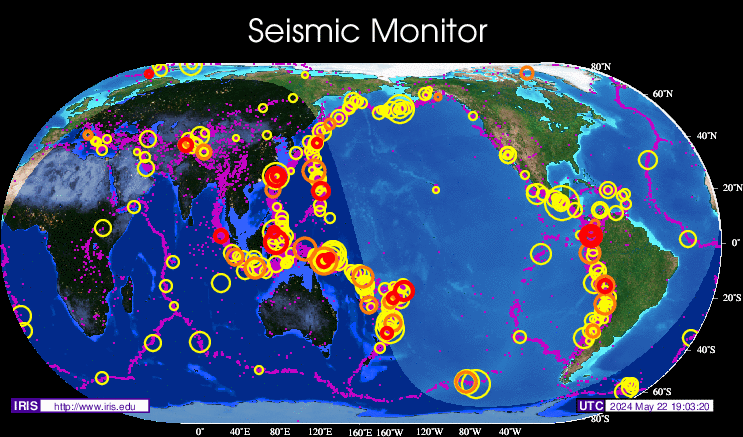There's a 100 percent chance of an earthquake today. Though millions of persons may never experience an earthquake, they are very common occurrences on this planet. So today -- somewhere -- an earthquake will occur.
It may be so light that only sensitive instruments will perceive its motion; it may shake houses, rattle windows, and displace small objects; or it may be sufficiently strong to cause property damage, death, and injury.
It is estimated that about 700 shocks each year have this capability when centered in a populated area. But fortunately, most of these potentially destructive earthquakes center in unpopulated areas far from civilization.
Since a major portion of the world's earthquakes each year center around the rim of the Pacific Ocean (Ring of Fire), referred to by seismologists as the circum-Pacific belt, this is the most probable location for today's earthquake. But it could hit any location, because no region is entirely free of earthquakes.
Stating that an earthquake is going to occur today is not really "predicting earthquakes". To date, they cannot be predicted. But anyone, on any day, could make this statement and it would be true. This is because several million earthquakes occur annually; thereby, thousands occur each day, although most are too small to be located. The problem, however, is in pinpointing the area where a strong shock will center and when it will occur.
Earthquake prediction is a future possibility, though. Just as the Weather Bureau now predicts hurricanes, tornadoes, and other severe storms, various seismology units may one day issue forecasts on earthquakes. Earthquake research was stepped up after the Alaska shock in 1964. Today, research is being conducted by the a num ber of agencies across the globe, as well as universities and private institutions. Earthquake prediction may some day become a reality, but only after much more is learned about the earthquake mechanism.

The map above is "live" showing recent global seismic activity
There are a number of resources to track recent global seismic activity.
Global Map
Interactive earthquake map
More Earthquake resources
Durban Earthquakes
Durban does not lie on any major fault lines (unlike San Francisco or Japan), but this does not mean that earthquakes are impossible and will not occur - and also in times gone by, this area had a lot more geological activity - especially as the super continent Gondwanaland drifted apart.
Ground Zero
You are now standing on a fault line - i.e. an area where a "earthquake" occured many years ago. This fault is likely to have occured in the Mesozoic era (during the time that Gondwana was splitting from the northern super continent of Laurasia and the various modern continents started taking their current form). This was around 100 million years ago (somewhere towards the end of the Jurassic era - so it is very likely that some of those dinosuars could well have been a little shaken and stirred by the movements). It is during this time that the Drakensberg mountain rocks were depositied - although you should be able to see if there is a darker grey basalt in this fault or not. The underlaying rocks that the fault cut through (on either side of the fault) are much older (laid down in the early Jurassic and Paleozoic era), up to 570 million years ago.
TASKS
1) Describe the fault zone (give a description from the inland - Pietermaritzburg/Westville side - towards the sea/shopping centre).Give specific mention on the types of rocks you think are on each side of the fault zone.
2) Look carefully at the fault zone itself and describe how it differs from the rocks on the left and right. also estimate the width of the fault zone.
3) Do you think this fault was a SLIP FAULT(i.e. stayed horizontal and two planes slipped past each other) or a NORMAL FAULT (i.e. one side moved upward in relation to the other side)? Explain why you decided this.
